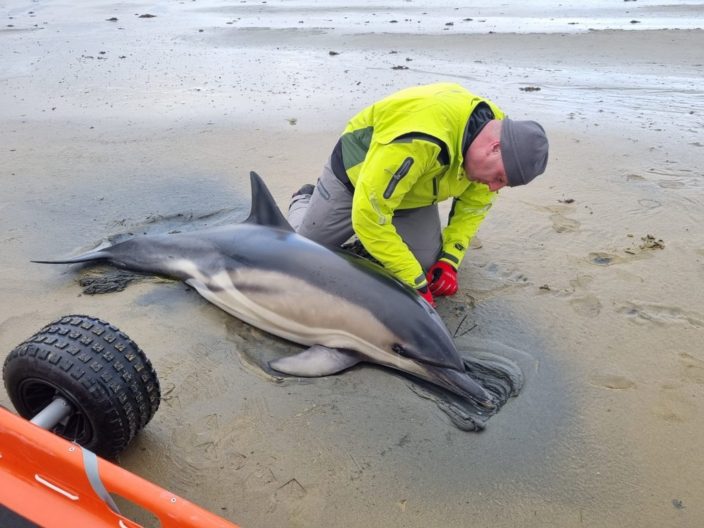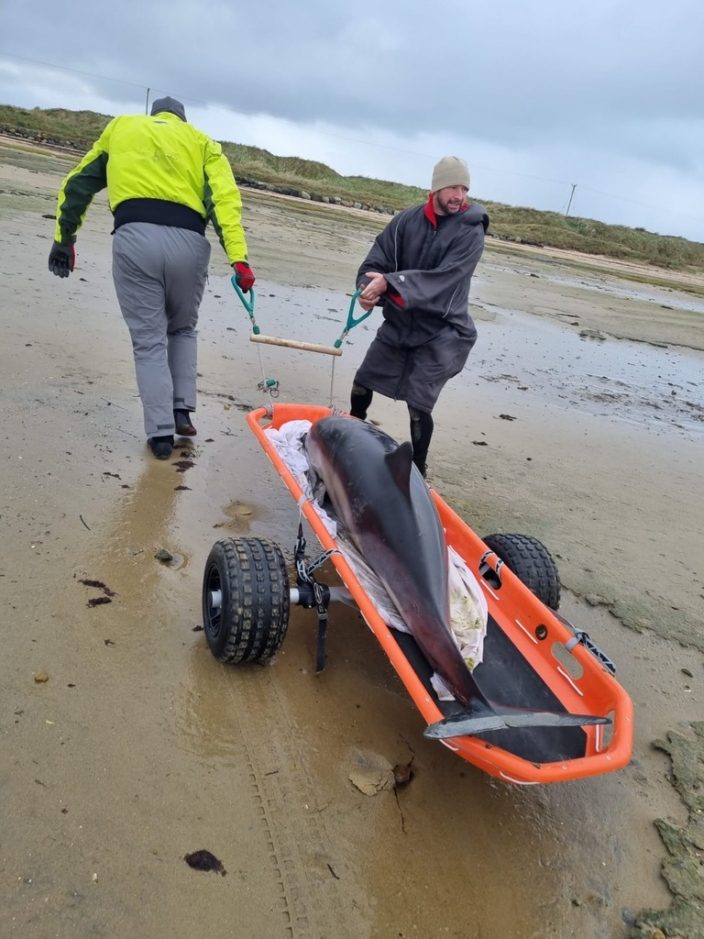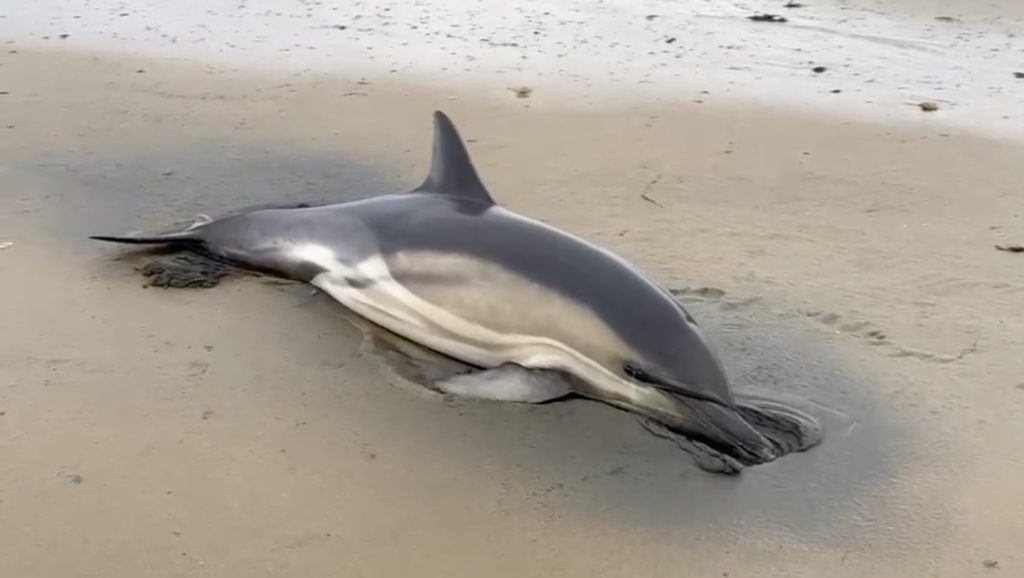On Saturday, 30th November 2024, Gemma received a call from Belmullet Garda Station about a live-stranded common dolphin near the Claggan Island causeway, Belmullet. This marked the third weekend in a row that a common dolphin had live-stranded in Ireland.
The adult female was in good condition. Due to the remote location, she was initially relocated by stretcher to the south side of Claggan Island to cool down in the water, and an attempt was made to refloat her. Concerned more dolphins might be in difficulty, the area was checked, and locals checked hotspots in Tarmon, which was thankfully clear.

Deteriorating weather hampered the refloat, so with help from Laurence Howard, the dolphin was transported by jeep to Ballyglass Pier, a more sheltered location. Thankfully, she was not found stranded again the next day, raising hope she is now at sea, recovering from the ordeal.
Sadly, new reports of dead dolphins were received on Sunday. Four common dolphins were found deceased around Blacksod Bay, including two at a known stranding hotspot, suggesting a pod encountered difficulties somewhere either at the same time as Saturday’s stranding or during the low tide overnight.
A heartfelt thanks to all involved: Anthony, who first reported the dolphin; Tom Breathnach, the main responder; Cillian O’Mongain for assisting and delivering equipment; Eilke, Agatha Hurst, Laurence Howard of Belmullet Coast Guard Station and Glamping; Niamh Martin; and Micheal Reilly.

Photos: Agatha Hurst
An explanation of terms
The following are short explanations of terms used and noted observations. These and more are covered in detail in IWDG Live Stranding Courses. Details of our 2025 courses around Ireland will be made available in early 2025.
- Pelagic Dolphin – Species of dolphins that primarily inhabits the open ocean, away from coastal areas. e.g Common dolphins, Atlantic white sided dolphins..These dolphins are highly adapted to life in deep, offshore waters, often ranging far from land.
- Coastal Species – Dolphin species or porpoises that primarily inhabit shallow waters near coastlines, bays, estuaries, and river mouths are well-adapted to life in nearshore environments. Examples include bottlenose dolphins and harbour porpoises.
- Breathing rate – A healthy, calm dolphin’s breathing rate is 2–5 breaths per minute. A rate of 6–10 breaths per minute indicates the dolphin is stressed or its breathing is compromised. More than 10 breaths per minute suggests the dolphin is severely stressed or has serious respiratory problems. This rate can return to normal when the stress is reduced, the dolphin is cooled, or trenches are dug under the animal to relieve pressure on the pectoral fins and lungs. However, if the breathing rate doesn’t decrease after first aid is administered, it indicates a poor prognosis for the dolphin.
- First aid – Positioning, cooling, calming, and protecting the dolphin from the sun or wind are critical (attend an IWDG Live Stranding course to learn how to help a live-stranded dolphin).
- Startled – Common dolphins, in particular, startle easily when live stranded. It is best to let them see you at all times, approach slowly, and keep the area quiet. Volunteers should work in hushed voices. Dolphins can calm when they realise you aren’t a threat. Handling should be kept to a minimum, and first aid should be given promptly.
- Listing – When a dolphin live strands and lists to one side, the lung on the downward side is compressed, causing the opposite lung to over-inflate slightly to compensate. When the dolphin re-enters the water with this lung imbalance, it may continue to list to one side. This imbalance can recover over time, and the dolphin’s position in the water may become more neutral.
- Live Stranding – A live stranding occurs when a dolphin, whale, or porpoise is beached alive, out of the water. This is more common in Common dolphins, which are a pelagic species and unfamiliar with local coastlines, unlike Harbour porpoises or Bottlenose dolphins. When Common dolphins feed closer to the coast or venture over flat areas with sandbars or mudflats, they can become disoriented and fail to find their way out before the tide recedes, especially during spring tides.
- Survival time – Dolphins breathe air through the blowhole at the top of their head, so they can survive out of water for a significant time, often hours, if cared for properly. However, a live stranding for a dolphin is akin to a car crash for us, taking a massive toll on its body. Dolphins survive longer when trained IWDG volunteers attend to them and provide first aid, but the longer they remain out of water, the more severe the effects of the stranding. Some dolphins are highly susceptible to stress and can die quickly from shock, especially if mishandled or attacked by gulls. Overheating out of water severely compromises a dolphin’s health, as does lying on their side while stranded. Large whales, unfortunately, face additional challenges due to their immense weight, which can cause muscle breakdown, clog their kidneys, and lead to renal failure, among other fatal conditions. As a result, large whales are not candidates for re-floating.
- Re-floating – if a dolphin is deemed a re-float candidate, it is first gently rolled on to a tarpaulin or rescue sheet using a technique taught in our live stranding courses. The tarpaulin is then lifted by around 6 people as a common can weight up to 130kg, and is placed no more than thigh to waist deep. It is then allowed to recover for a time before being released. A dolphins tail or fins should never be used to move or pull a dolphin as this can cause dislocation injuries to the dolphin.

